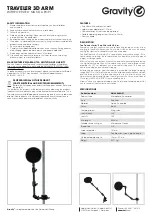
17
57-645 Eclipse Guided Wave Radar Transmitter - PROFIBUS PA
™
③
Align the probe process connection with the threaded or
flanged mounting on the vessel.
④
For threaded connections, tighten the hex nut of the probe
process connection. For flanged connections, tighten flange
bolts.
⑤
Probe can be shortened in field:
a. Raise TFE weight (1) exposing securing device (2).
b. Loosen both #10–32 set screws (3) using
3
⁄
32
" (2.5 mm)
hex wrench and remove securing device.
c. Cut and remove needed cable (4) length.
d. Reattach securing device and tighten screws.
e. Enter new probe length (inches or cm) in software.
⑥
Probe can be attached to the tank bottom using the
0.50" (13 mm)
∅
hole provided in the TFE weight.
Cable tension should not exceed 20 lbs.
3.4.4 Installation Guidelines
Models 7x2/7x5 Bulk Solids Probes
The Model 7x2 and 7x5 Bulk Solids probes are designed for
a 3000 lb. (1360 kg) pull-down force for use in applications
such as sand, plastic pellets and grains. It is offered with a
maximum 75 foot (22 meter) probe length.
Model 7x2 Single Rod — dielectric
≥
4
Model 7x5 Twin Rod — dielectric
≥
1.9
NOTE: Avoid cement, heavy gravel, etc.
3.4.4.1 Applications
1. Plastic pellets, sugar: Dielectric constant 1.9-2.0
2. Grain, seeds, sand:
Dielectric constant 2.0-3.0
3. Salts: Dielectric constant 4.0-7.0
4. Metallic powder, coal dust:
Dielectric constant >7
3.4.4.2 Mounting recommendations
1. Use a weight instead of securing the probe to the vessel.
2. Mount probe at least 12 inches from the wall. Ideal
location is
1
⁄
4
to
1
⁄
6
the diameter to average the angle
of repose.
3. A metal flange must be used when mounting on plastic
vessels.
3.4.4.3 To install a Model 7x5 bulk solids flexible twin rod
probe:
①
Make sure the process connection is at least 2" NPT or a
flanged mounting.
1
0.50" (13 mm) Ø
2
3
4
⑤
①
②
③
④
















































